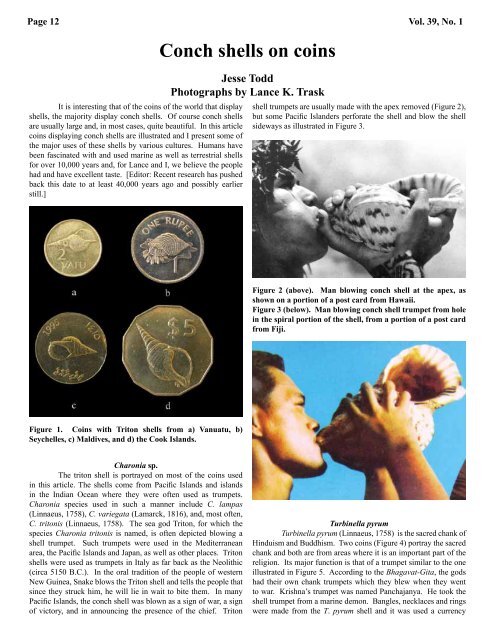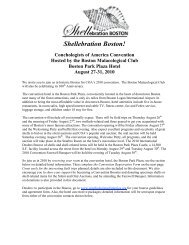download PDF - Conchologists of America
download PDF - Conchologists of America
download PDF - Conchologists of America
Create successful ePaper yourself
Turn your PDF publications into a flip-book with our unique Google optimized e-Paper software.
Page 12 Vol. 39, No. 1<br />
It is interesting that <strong>of</strong> the coins <strong>of</strong> the world that display<br />
shells, the majority display conch shells. Of course conch shells<br />
are usually large and, in most cases, quite beautiful. In this article<br />
coins displaying conch shells are illustrated and I present some <strong>of</strong><br />
the major uses <strong>of</strong> these shells by various cultures. Humans have<br />
been fascinated with and used marine as well as terrestrial shells<br />
for over 10,000 years and, for Lance and I, we believe the people<br />
had and have excellent taste. [Editor: Recent research has pushed<br />
back this date to at least 40,000 years ago and possibly earlier<br />
still.]<br />
Figure 1. Coins with Triton shells from a) Vanuatu, b)<br />
Seychelles, c) Maldives, and d) the Cook Islands.<br />
Charonia sp.<br />
The triton shell is portrayed on most <strong>of</strong> the coins used<br />
in this article. The shells come from Pacific Islands and islands<br />
in the Indian Ocean where they were <strong>of</strong>ten used as trumpets.<br />
Charonia species used in such a manner include C. lampas<br />
(Linnaeus, 1758), C. variegata (Lamarck, 1816), and, most <strong>of</strong>ten,<br />
C. tritonis (Linnaeus, 1758). The sea god Triton, for which the<br />
species Charonia tritonis is named, is <strong>of</strong>ten depicted blowing a<br />
shell trumpet. Such trumpets were used in the Mediterranean<br />
area, the Pacific Islands and Japan, as well as other places. Triton<br />
shells were used as trumpets in Italy as far back as the Neolithic<br />
(circa 5150 B.C.). In the oral tradition <strong>of</strong> the people <strong>of</strong> western<br />
New Guinea, Snake blows the Triton shell and tells the people that<br />
since they struck him, he will lie in wait to bite them. In many<br />
Pacific Islands, the conch shell was blown as a sign <strong>of</strong> war, a sign<br />
<strong>of</strong> victory, and in announcing the presence <strong>of</strong> the chief. Triton<br />
Conch shells on coins<br />
Jesse Todd<br />
Photographs by Lance K. Trask<br />
shell trumpets are usually made with the apex removed (Figure 2),<br />
but some Pacific Islanders perforate the shell and blow the shell<br />
sideways as illustrated in Figure 3.<br />
Figure 2 (above). Man blowing conch shell at the apex, as<br />
shown on a portion <strong>of</strong> a post card from Hawaii.<br />
Figure 3 (below). Man blowing conch shell trumpet from hole<br />
in the spiral portion <strong>of</strong> the shell, from a portion <strong>of</strong> a post card<br />
from Fiji.<br />
Turbinella pyrum<br />
Turbinella pyrum (Linnaeus, 1758) is the sacred chank <strong>of</strong><br />
Hinduism and Buddhism. Two coins (Figure 4) portray the sacred<br />
chank and both are from areas where it is an important part <strong>of</strong> the<br />
religion. Its major function is that <strong>of</strong> a trumpet similar to the one<br />
illustrated in Figure 5. According to the Bhagavat-Gita, the gods<br />
had their own chank trumpets which they blew when they went<br />
to war. Krishna’s trumpet was named Panchajanya. He took the<br />
shell trumpet from a marine demon. Bangles, necklaces and rings<br />
were made from the T. pyrum shell and it was used a currency




